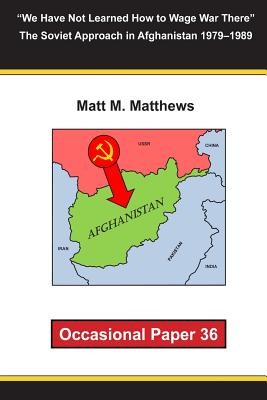
- We will send in 10–14 business days.
- Author: Matt M Matthews
- Publisher: CreateSpace Independent Publishing Platform
- Year: 2012
- Pages: 84
- ISBN-10: 1470084325
- ISBN-13: 9781470084325
- Format: 15.2 x 22.9 x 0.4 cm, minkšti viršeliai
- Language: English
- SAVE -10% with code: EXTRA
"We Have Not Learned How to Wage War There" The Soviet Approach in Afghanistan 1979-1989 (e-book) (used book) | bookbook.eu
Reviews
Description
The Combat Studies Institute (CSI) is pleased to present its latest publication in the Occasional Paper Series, "We Have Not Learned How to Wage War There" The Soviet Approach in Afghanistan,1979-1989, by Mr. Matt Matthews. For this work, Mr. Matthews collected a wide variety of sources on the subject, many of them of primary accounts, and used these materials to provide an overview of the evolution of the Soviet operational approach in Afghanistan between 1979 and 1989. This Soviet experience offers a number of useful insights for American military professionals who are, as of this writing, conducting operations in Afghanistan. Mr. Matthews begins his study by examining the Soviets' planning for its invasion of Afghanistan and initial goals for that campaign. The author then looks closely at how the Soviets adapted their tactics and organization to meet the committed and resilient insurgent threat that emerged to do battle against Soviet forces. Despite conventional interpretations of this campaign in Afghanistan which emphasize the rigidity of Soviet methods, Matthews' study suggests that the Soviets were flexible in their overall approach. The Soviet government did, for example, launch nation-building initiatives that would look familiar to American military officers who served in Afghanistan in the first decade of the 21st century. These efforts, however, were seriously hindered by a Soviet military culture that opposed a more comprehensive campaign to foster a popular central Afghan government. Matthews concludes his study by examining Soviet operations to extract their forces from Afghanistan while nonetheless leaving a viable, if not popular, Afghan government in place.
EXTRA 10 % discount with code: EXTRA
The promotion ends in 21d.05:05:04
The discount code is valid when purchasing from 10 €. Discounts do not stack.
- Author: Matt M Matthews
- Publisher: CreateSpace Independent Publishing Platform
- Year: 2012
- Pages: 84
- ISBN-10: 1470084325
- ISBN-13: 9781470084325
- Format: 15.2 x 22.9 x 0.4 cm, minkšti viršeliai
- Language: English English
The Combat Studies Institute (CSI) is pleased to present its latest publication in the Occasional Paper Series, "We Have Not Learned How to Wage War There" The Soviet Approach in Afghanistan,1979-1989, by Mr. Matt Matthews. For this work, Mr. Matthews collected a wide variety of sources on the subject, many of them of primary accounts, and used these materials to provide an overview of the evolution of the Soviet operational approach in Afghanistan between 1979 and 1989. This Soviet experience offers a number of useful insights for American military professionals who are, as of this writing, conducting operations in Afghanistan. Mr. Matthews begins his study by examining the Soviets' planning for its invasion of Afghanistan and initial goals for that campaign. The author then looks closely at how the Soviets adapted their tactics and organization to meet the committed and resilient insurgent threat that emerged to do battle against Soviet forces. Despite conventional interpretations of this campaign in Afghanistan which emphasize the rigidity of Soviet methods, Matthews' study suggests that the Soviets were flexible in their overall approach. The Soviet government did, for example, launch nation-building initiatives that would look familiar to American military officers who served in Afghanistan in the first decade of the 21st century. These efforts, however, were seriously hindered by a Soviet military culture that opposed a more comprehensive campaign to foster a popular central Afghan government. Matthews concludes his study by examining Soviet operations to extract their forces from Afghanistan while nonetheless leaving a viable, if not popular, Afghan government in place.


Reviews